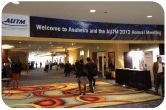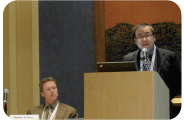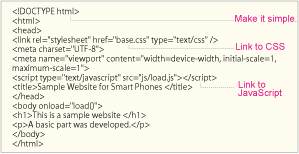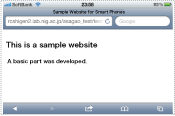|
 |
■ Bioresources information is available at the following URLs
|
 |
|
Prospects for MTAs in the USA
Mutsuaki Suzuki, Director, Intellectual Property Unit, National Institute of Genetics
| A material transfer agreement (MTA) is required prior to distribution of materials such as biological genetic resources or tangible research achievements. Although time-consuming negotiations for MTAs between nonprofit organizations should be avoided, the current circumstances are not yet ideal. Recently, I participated as a lecture panelist at the MTA section meeting of the 2012 meeting of the Association of University Technology Managers (AUTM) held in Anaheim, California. In this issue, I will report the proceedings of this meeting to introduce the present circumstances of MTAs in the USA.
1. Stop or integrate MTAs? Activities of the MTA-WG |
Dr. Stephen Harsy from the University of Wisconsin, a moderator of the MTA section meeting, introduced the current situation of MTAs and the MTA working group (MTA-WG).
In Chapter 8 of the 2010 Report, the National Academy of Sciences encouraged the following regarding future scientific material transfers.
1) MTAs should be abolished when transferring non-toxic, non-human-derived materials for in vitro research between nonprofit organizations.
2) A universal Biological MTA (UBMTA), as recommended by the National Institutes of Health (NIH) or a service level agreement (SLA) should be used between nonprofit organizations.
|
|
Moreover, the results of the 2011 MTA Survey conducted by the AUTM showed that the frequency of UBMTA/SLA use is not very high, and the reasons for not using the UBMTA were as follows:
- Each university uses a template that is similar to the UBMTA.
- Confidentiality and pre-publication article review need to be implemented.
- Some articles in the UBMTA are difficult to understand.
- Could not find the required signees.
|

A view of the conference (Mariott Anahaim Hotel) |
To resolve these issues, Dr. Stephen Harsy and others founded the MTA working group (MTA-WG) last year.
The goal of MTA-WG is to clarify the reasons for not using the UBMTA or SLA, and to develop recommended practices and guidelines for promotion. In addition, the activities of "NO-MTA∗" were reviewed.
-----------------------------
2. Material Transfer: Principles for Developing Guidelines
Dr. Wendy Streize, a member of the MTA-WG (University of California), explained the preparation of the Guiding Principles for developing the guidelines for fundamental concepts of MTAs. The Guiding Principles consist of 14 principles for material transfers between academic institutions, which are based on the premise that the transferred non-toxic materials have been published and will not be used in humans.
For example, a recipient cannot transfer the material to a third person, but a new material that was developed using the transferred material should be allowed to be used in nonprofit research to validate published results. In addition, the provider should not demand rights regarding the inventions of the recipient. Another principle states that a provider should not request a review or a reprint of the recipient’s publication.
3. Modification of the UBMTA
Next, Dr. Michael R. Mowatt, National Institute of Allergy and Infectious Diseases (NIAID), a member of the MTA-WG, explained the modification of the UBMTA. The MTA-WG proposed modifications of the UBMTA to promote its use. In the execution form of the UBMTA, a description of the research purpose was allowed and a description of export regulations was added. In addition, UBMTAs specific to each material type, such as chemical compounds, human samples, and iPS cells, were drafted.
This modified UBMTA, including the aforementioned principles, has been released, and on the website of the MTA (www.autm.net/Proposed_MTAs.htm) section meeting of AUTM opinions are currently being solicited. In addition, the transfer agreement dashboard (TAD), the MTA administration system at the NIH, which uses digital signatures, was also introduced.
4. Relieving international obstacles of material transfer
|
Finally, the author discussed simplifying international material transfers. Recently, the aforementioned AUTM MTA survey was conducted at 12 universities in Japan.
Comparison of the responses from universities in Japan and those in the USA showed that while in the USA, MTAs are handled by a technical transfer department, in Japan, MTAs are handled by both a technical transfer department and a faculty office. An interesting result was the differences regarding the provisions of MTAs between the USA and Japan. Japan is more permissive than the USA in terms of provisions on pre-publication review, need for the researcher’s signature, and the laws of other countries. In contrast, the provisions related to permission for free-of-charge license use to providers, extension of release for a patent application, and handling of secret information for 5 years of more, are stricter in Japan than in the USA. Moreover, based on the results of a survey conducted with the Toyohashi University of Technology, I pointed out the insufficiencies in the international system for MTAs in Japan.
|

MTA section meeting at the 2012 annual meeting of the AUTM
The author (right) and Dr. Stephen Harsy (left), University of Wisconsin
|
In conclusion, I proposed the need for an understanding of the differences in the MTA framework in each country and international standardization of common recognitions and templates for MTAs to relieve international obstacles of material transfer.
Summary: Future Activities and Standpoints as a Biological Genetic Resource Distributor
The activities of Dr. Stephen Harsy, et al. are going to change the status of the long, chaotic MTA. Material transfers between non-profit organizations should be conducted as efficiently as possible. I hope that the Guiding Principles and the modified proposals for the UBMTA will simplify material transfers. Hopefully, in the future, MTAs between universities will be simplified to some extent and use of a uniform system will be more widespread than it is now. Regardless, there is a long journey ahead to abolish MTAs that are specific to each university.
Moreover, ATCC, the largest cell bank in the USA, stated the necessity of ATCC’s original MTA to guarantee resource quality, claiming that the UBMTA includes provisions such as distribution of modified materials, which is incompatible with the aim of ATCC as a distributor. Obviously, ATCC does not plan to adopt NO-MTA.
Arguments for MTAs regarding the distribution of biological genetic resources may arise in future. However, for biological resource distribution, it is expected that, rather than NO-MTA or a unified MTA system, a more simplified, perhaps web-based, system will be adopted to accelerate and simplify the MTA process. |
|
|
Website Development for Smart Phones |
According to recent statistics, the percentage of smart phone users among mobile device users exceeds ∼20%. Increasing number of smart phone users are away from their PCs and actively using networks since users can often browse websites outside their homes and do not need to boot their PCs to do so.
Smart phones are also a significant web-browsing terminal, and model websites such as Yahoo! and Google have only a search window, which is a common design characteristic. In this issue, I will introduce an example of a simple website for smart phone display.

Necessary development environments
HTML5 is the language that is primarily used, while CSS3 and JavaScript are also used as necessary. Touch manipulation is the basic operation in smart phones; thus, JavaScript is used if tap, slide, flick, and pinch operations are used.

Smart phone specifications
The specifications of each operating system (OS) are shown in Fig. 1. For the development of a simple website, differences among the smart phone models need not be considered too much.
 |

Let’s develop a website!
Type the following HTML code:
|
 |

Figure: Example website shown in a smart phone using the HTML code left. |
As shown above, the codes are mostly ordinary HTML; however, there is an unfamiliar meta tag, "viewport." This is to specify the design that matches the display of a mobile device. In addition, the first DOCTYPE statement was also simplified.
Since the basics are very simple, please try this!
(Manabu Hattori) |
|
"Wetware − A Computer in Every Living Cell"
Written by Dennis Bray and translated by Remi Kumagai, et al. (Hayakawa Publishing Corporation, 2011). |
Microbes perceive the concentration of an organic nutrient and move toward the direction of higher concentration, comparing the current concentration with the previous concentration using short-term memory (chemotaxis). According to the author, this is most likely a sort of differential calculation. In contrast to the hardware and software in a computer, cells appear to use wetware to perform calculations.
Among single-cell organisms, eukaryotes such as amoeba exhibit even more breathtaking moves. When an amoeba goes after its prey (the cyst membrane of Euglena) it looks like a puppy chasing a ball. In addition, an amoeba differentiates its prey from sand granules, and if it eats a sand granule, it immediately spews it out. This behavior of infusoria, including amoebas, implies the existence of an "inner state"(or sprouting "consciousness") that includes starvation, fatigue, pleasure, and displeasure.
One hundred years ago, observations of infusoria were on the cutting-edge of biology; however, biological science subsequently advanced over time to analytical research. The author insists that we should recruit our abundant knowledge at the molecular level, such as molecular biology, and re-tackle single-celled organisms. The author Dennis Bray is one of the authors of "Essential Cell Biology," a textbook familiar to biology researchers, and thus, such a claim makes a strong impression on us. (K.N.)
|
|
|